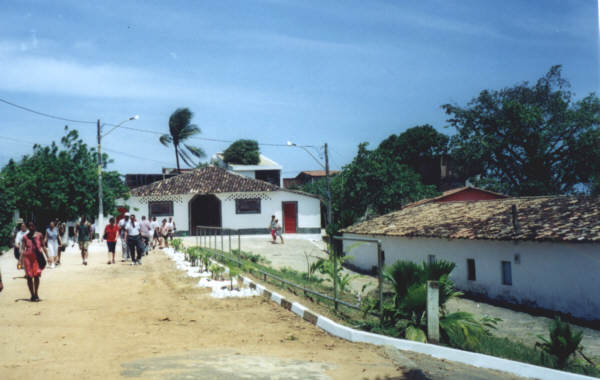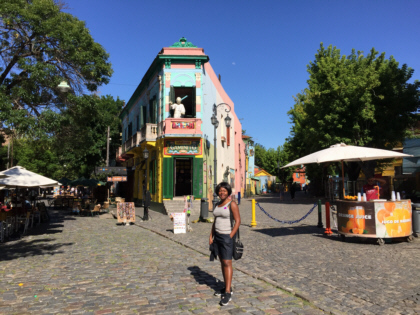Salvador da Bahia (continued)
Tuesday Night In Bahia
Tuesday nights are party nights in Bahia. Traci and I hooked up with another couple from our tour group and caught a cab to the Old City. On Tuesday nights, the Pelourinho area is bustling with activity. There is live music in just about every club and bar. There are groups practicing their drumming in the alleys. There are long lines for a fortune teller. The souvenir shops are very busy. You can smell different food every time you turn a corner. There is a big stage set up in the square in front of São Francisco Church. Crowds of people stroll the cobblestone streets while others just hang out and people watch. There is a significant police presence in the area, so we always felt safe. I only saw one incident that evening involving what appeared to be an argument between some teens, but the police broke it up quickly.
We spent a few hours exploring the Bahian nightlife before heading back to the hotel. I recommend wearing comfortable shoes when walking the streets of the Pelourinho section. It didn't take long before the cobblestone streets started to become uncomfortable to walk on. It felt good to finally sit in the taxi and enjoy the ride back to the hotel.
As a side note, I recommend reaching a price agreement with the taxi driver before getting into the car. We had an incident that evening where the driver charged us $17 reals per person for the ride back when we only paid $5 reals when we came. Although, none of the four of us who were in the cab spoke Portugese, I think the driver understood us when we "strongly disagreed" with his price. He dropped our fare to $8 reals per person. To avoid these unnecessary disputes, be sure to agree on the price beforehand or get a metered cab.
African Heritage Tour (optional tour)
We got an early start again the next day to take the African Heritage Tour. Our first stop was a Candomblé community. The major religions of Bahia are Catholicism and an African-rooted religion called Candomblé. The Candomblé religion has several deities or orixás. The Candomblé practicioners dance themselves into a trance in order to get closer to these orixás. We did not witness any of the religious ceremonies; however, we were allowed to see some of the worship places and to meet some of the people in the community. Paula, our tour guide, gave excellent narration of the complex and seemed to know everyone who lived and worshipped there.

Candomblé community

Candomblé orixás
The final stop of our tour was to the meeting place of the members of Ilê Aiyê. This small building was located in a residential neighborhood. The first thing I noticed about the building was its very bright yellow and red patterns.
We met the president and founder of Ilê Aiyê, Antônio Carlos Vovô. Paula acted as the translator as Mr. Vovô told us the history of Ilê Aiyê which began in 1974. Ilê Aiyê also participates in Carnival and are very good musicians and performers. For years blacks were not allowed to participate in the Carnival celebration but today Ilê Aiyê is one of the favorites in Salvador da Bahia. We met some of the musicians of the group. I bought one of their CDs and got their autographs. The CD is very good. It has excellent Bahian drumming with chants and lots of call-and-response singing.

Front of the Ilê Aiyê building

Traci and me with Antônio Carlos Vovô (right), president of Ilê Aiyê
I really enjoyed the tours we did in Bahia. I was exposed to so many aspects of Bahian society that were totally foreign to me. The people seemed so friendly and dignified. For example, one of our tours took us through some very impoverished areas. I remember seeing a group of 30 to 40 men just standing along the side of the road. Paula told us that unemployment is very high in Brazil. She told us the men we saw had probably heard of a work opportunity and were waiting for a truck to pick them up and give them a job. Many times the truck comes by and only needs a handful of men. Despite, this desperate situation, these men smiled and waved to us as we rode by.
Later that day, the whole tour group was taken in several buses to a churrascaria for lunch. It had a large buffet filled with many types of Bahian food. The buffet line moved pretty quickly; however, since my hotel group was one of the last to arrive, it was pretty hard to find a seat. Eventually, Traci and I found seats at the same table. The waiters continuously came to our table with the meat rods, just as they did in Rio, until we waved them off. I enjoyed trying the different foods from the buffet; however, there was nothing that I thought tasted exceptionally good. On the other hand, there was a dessert bar filled with fruit and tropical-flavored ice cream (coconut, mango, etc...). These desserts were very good.
Gem Dealer Excursion (optional tour)
Brazil is a large producer of precious gems. We had already done a tour of the H. Stern gem factory in Rio de Janeiro so there were only a few of us who signed up for the optional gem dealer excursion in Salvador. We were transported in a few cars and a van. Our driver was one of the most aggressive drivers I've ever seen. He managed squeeze between two cars riding in adjacent lanes on a highway while going well above the speed limit. Scary!

The gem dealer shows us expensive diamonds and emeralds
We arrived at our destination in one piece (Praise God!). To my surprise we were not at a store or factory - we were at the dealer's house. It was a nice, quaint house with a well-kept yard on the outskirts of the city. The dealer, Eliene, invited us into his dining room where he gave us an overview the process of mining gems and getting them to the all the consumer. He then began to draw grids on some paper he had on the dining room table. Next, he opened one of his boxes, took out some pouches, and began grouping all types of gems within the grid lines he had drawn. There were diamonds, emeralds, rubies, and many others. Over the next hour, Eliene showed all types of gemstones ranging in price from a hundred dollars to several thousand dollars (Talk about bling!). We were given the opportunity to purchase the stones at a reduced price and have them set. Some people in our group made purchases. Continue...




